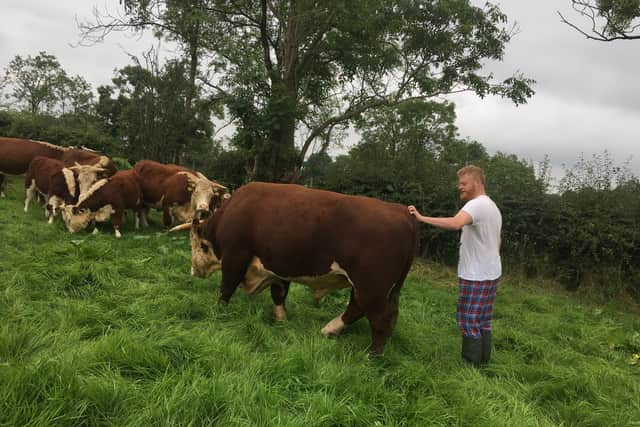Video: Watch how this native Hereford herd has been settling into new NI home
and live on Freeview channel 276
In late September Co Antrim man Robert Shaw imported the rare breed across from the mainland, a move which saw him achieve a long held ambition to own some original Herefords.
Traditional Hereford cows are long lived, fertile and maternal. They make great suckler cows and can produce calves at up to 14 years old. The breed is very docile and easily managed. They are also hardy and suited to outwintering.
Advertisement
Hide AdAdvertisement
Hide AdThe Traditional Hereford is much shorter legged than the modern Hereford.


Robert, who has been farming at Templepatrick for 30 years, explained how he had a small herd of 11 or 12 Herefords, but he wanted the original Herefords as they are smaller and have big horns on them.
He continued: “When I was younger I worked with them and then they disappeared in this country. The Americans got the hold of them and they bred other breeds into them to make them bigger.
“There is a man in England - David Fenton - and he was wanting the original Hereford and searched all over the world for them and at last he got them and he has bred them up and has 120 of them now.
Advertisement
Hide AdAdvertisement
Hide Ad“David Fenton lives in Kent and he has a farm shop and he has a big enterprise over there. He does the original pigs and all the rest of it. The original Herefords now are a rare breed. I think there are four or five breeders over in England. I was speaking to David’s farm manager and I said that I couldn’t trace them at all. He said that there might be some in Ireland somewhere, but there were no pedigree ones in Ireland.”
Robert described the process of bringing the cattle over from GB to Northern Ireland as ‘unbelievable’.
“First of all we started last February or April and it took from then up until about four weeks ago to get all the book work done. On top of that when the lorry driver brought them over, the day before they were due to come over here, they were told that they would have to put another ear tag in them saying Great Britain on it. So that was three ear tags they had. Whenever the lorry driver arrived in Larne they took every one of them off the lorry, went through every one of them.”
For Robert the problems didn’t end there and there was confusion around whether or not the cattle, which had already been tested for BVD, would have to be re-tested. Eventually the issues were resolved, but Robert admits it was very frustrating.
Advertisement
Hide AdAdvertisement
Hide AdHe added: “You see every department I was in touch with they all said this was a learning job - that they didn’t know how to handle this and the girl at the Hereford Society this morning, she wasn’t sure whether she was to give me new pedigree cards or what to do, so that’s how hard it is.”
Robert plans to breed the herd as a strictly original Hereford breed. He will be keeping his other Herefords but will probably decrease them over time.
Amongst the new arrivals are ten cows, ten calves and a bull.
“Out of those ten calves I got two bulls so that I can use them in the future and then hopefully I will be able to buy straws if need be,” said Robert.
Advertisement
Hide AdAdvertisement
Hide Ad“But the bull I bought is a powerful good bull. I will be able to use the same bull with the cows. If you read up on those original Herefords you will see that they finish off grass, they don’t be fed meal. They will breed up to 17 or 18 years old.”
Robert says they plan to show their new native Herefords at some stage.
He is delighted with the docile nature of the new herd: “People have come to see them and they are the sort of cattle you couldn’t chase them away from you they are that quiet.
“In fact a fella came over to see them there last week and he came over to have a look at the bull which was lying down. He touched the bull with his foot to get him up and have a look at him. The bull got up and he walked all round it and had a good look and then walked back to me and the bull he just lay down again.
Advertisement
Hide AdAdvertisement
Hide Ad“We were changing them from a field going up a lane. The bull was at the back and my grandson was walking along beside him and he started to rub his back and the bull stopped. When my grandson stopped rubbing his back he started to walk again. So he tried again - he rubbed his back again and he stopped again. I had to say to him ‘leave that bull alone or we will never get them into this field’,” Robert laughed.
Comment Guidelines
National World encourages reader discussion on our stories. User feedback, insights and back-and-forth exchanges add a rich layer of context to reporting. Please review our Community Guidelines before commenting.